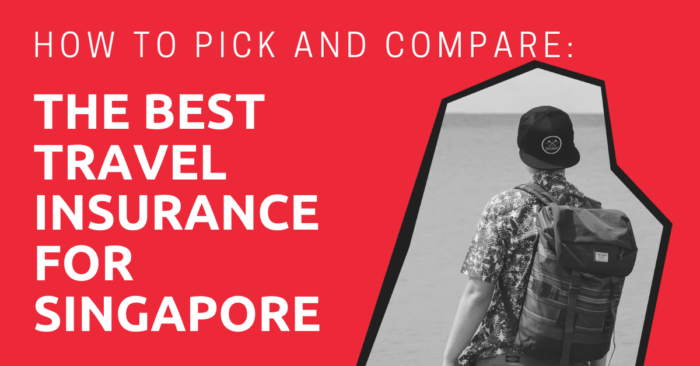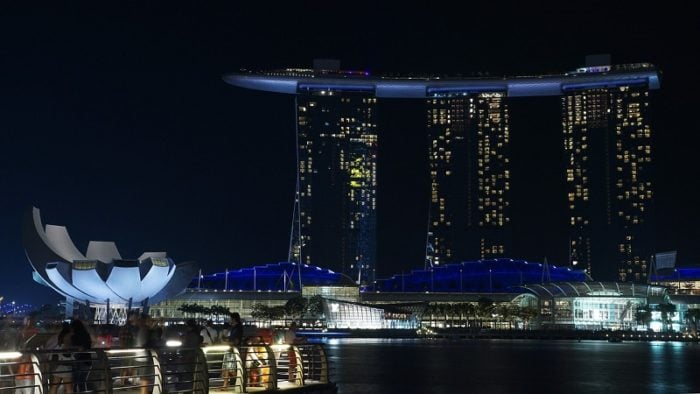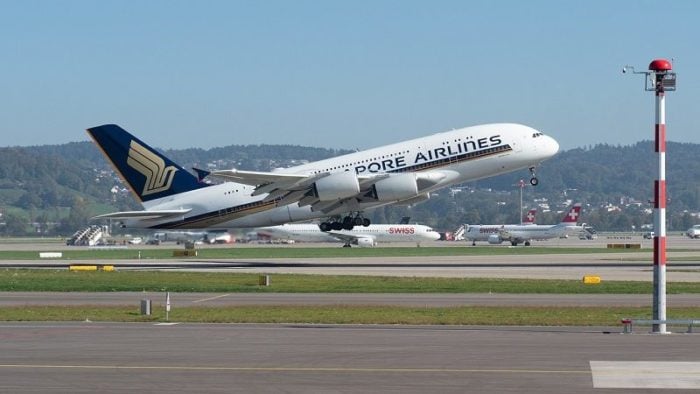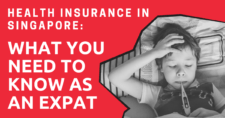
‘Why do I need travel insurance for Singapore?’ I hear you ask.
‘Isn’t Singapore one of the safest countries in the world to travel in?’
Well, it’s true that Singapore is one of the safest cities in the world.
However, there are still many reasons that travel within Singapore can go wrong. In addition, it gives you peace of mind that there may be financial protection should something occur.
In this article, I’ll outline how to pick the best travel insurance for a trip to Singapore. I’ll also review some of the most popular travel insurance plans available, their coverage and exclusions, and how to make a claim should you need to.
This article will take approximately 29 minutes to read. Don't have the time right now? No worries. You can email the ad-free version of the article to yourself and read it later!
Disclaimer: This article may include links to products or services offered by ExpatDen’s partners, which give us commissions when you click on them. Although this may influence how they appear in the text, we only recommend solutions that we would use in your situation. Read more in our Advertising Disclosure.
Contents
Key Takeaways
- While Singapore is a very safe country, having travel insurance provides additional protection in case of an accident or sudden sickness.
- Contrary to other things in Singapore, travel insurance is affordable here, ranging from US$45 to US$150 for a 30-day plan.
- You have many choices of travel insurance to choose from. Some mainly focus on medical coverage, while others provide comprehensive coverage on travel benefits.
- ACS Globe Traveller is an affordable option. If you are looking for something more comprehensive, check out World Nomads.
- Still, it’s a good idea to read the fine print in detail to understand exactly what you get.
Why Do You Need Travel Insurance for a Trip to Singapore?
As outlined above, while Singapore might not be top of mind when you think of risky places to travel, there are still reasons why you might be grateful that you took out travel insurance before you boarded your airplane to the ‘Little Red Dot’.
Let’s look at what these include:
Sickness
Mosquito-borne diseases such as malaria, dengue fever and chikungunya are prevalent in Singapore and, if caught while you are travelling here, are likely to lead to an expensive trip to a private hospital for testing and subsequent treatment.
As can gastrointestinal problems, otherwise known as ‘Travellers Tummy’. Eating hot and spicy local food is one of Singapore’s national pastimes, but for those who aren’t accustomed to it, the change in diet or eating from a food stall with a poor hygiene rating might lead to a case of food poisoning and an expensive trip to the doctor.
Skin Infections
Singapore is hot and humid all year round and provides the perfect climate for fungal infections and other skin conditions such as eczema to thrive.
Many travelers have found themselves taking trips to the doctor for treatment for skin issues they don’t normally experience back at home.
Travel Interruptions
Changi Airport deservedly holds the reputation as the World’s Best Airport (as voted for consecutive times at World Airport Awards, as well as taking awards for World’s Best Airport Leisure Amenities and the Best Airport in Asia) but even this doesn’t prevent travel delays, disruptions, and other annoyances such as lost baggage from occurring.
Singapore’s tropical thunderstorms are frequent and heavy.
On average Singapore experiences 168 thunderstorm days per year, which can cause flights to be grounded while there is electrical activity in the skies above the airport.
You might be waiting in the nicest departure lounge you’ve ever been in, but you still could be waiting for some time.
Theft
Theft is a crime that people tend not to associate with Singapore, but the fact that it’s not widely reported in the media doesn’t mean it doesn’t happen.
Like anywhere in the world, if you leave your bag unattended in a nightclub while you go and buy a drink or have a dance, don’t expect to see it again.
Similarly, it’s probably best not to walk around tourist areas such as Chinatown or Little India with your phone, or worse still, a passport, hanging out of your pocket.
Common sense applies as much to Singapore as any city globally.
Accidents
It doesn’t matter where in the world you are, accidents can and do happen, and Singapore is no different in that respect.
Whether you simply leave your camera out on the sun lounger during one of the island’s heavy downpours, or run through a glass door not realising it was shut (as one of my friends did), you never know when you are going to need that accident insurance coverage.

But please, don’t let any of this scare you.
On balance, Singapore is a safe and easy city to travel in and you shouldn’t expect any major problems. Having travel insurance is simply about covering yourself in the unlikely event of a problem.
Wouldn’t you rather pay a small sum before your trip and know you are covered, than have to use the rest of your holiday budget buying a new set of clothes because yours had been lost by a baggage handler?
Am I Already Covered?
We’ve touched on bag theft and healthcare issues, so naturally you think you are already covered through your existing credit card and health insurance, right?
Wrong.
Sure, you have some coverage through these, but let me explain why it probably isn’t enough.
Credit Card Travel Insurance
Not all credit cards are made equal and therefore not all offer travel insurance as a benefit, but if you’ve already got yourself, say, an American Express or Visa credit card that collects airmiles, chances are you’ve got travel insurance benefits with it.
Of those card providers that do offer travel insurance benefits, it is likely only activated if you have purchased the full cost of your flight fares using the card.
In other words, if you redeemed any of the airmiles that you had also been collecting through your card, then you won’t be entitled to the complimentary travel insurance that the card also offers.
A bit cheeky but you have to think of it as similar to being unable to claim two different promotions for the same restaurant in one visit.
For some credit cards, purchasing the full cost of the flights on your card only unlocks the main travel insurance coverage. To access further benefits such as the lost baggage allowance you need to have directly activated the insurance plan with your card holder prior to travelling.
Once activated, the travel insurance benefits are generally pretty good.
On average, the principal or supplementary card holders are covered for claims up to US$750,000, with children covered up to between US$15,000 – $35,000. Accidental medical and dental coverage can be up to as much as US$3,000, and compensation can be claimed for baggage loss, baggage delay, flight delay, trip interruption, and trip cancellation.
The takeaway here is that if you think you are going to stick with the coverage provided by your credit card, make sure you have read the small print very carefully to identify whether you are really covered adequately and haven’t accidentally voided your own coverage by using airmiles to buy your flight in the first place.
Health Insurance
If you have health insurance, you should check whether it includes coverage in Singapore.
Since the cost of healthcare in Singapore is high, many international health insurance plans do not cover it.
If you have local health insurance or insurance provided by the government, such as social security, there is a chance that it won’t cover you in Singapore.
In addition, health insurance may pay for your trip to a hospital or dentist in Singapore while travelling, but it is not going to cover you for other potential travelling issues such as lost baggage or delayed or cancelled flights.
You can learn more about international health insurance plans here.
You should have got the picture by now – if you are planning a trip to Singapore, you are going to want to take out a separate travel insurance plan.
So let’s get into the nitty gritty details of travel insurance products – how much they cost, what they cover, and how to make a claim.
How Much Does Travel Insurance Cost?
While a trip to Singapore doesn’t necessarily require expensive coverage for adventurous activities such as skydiving and heli-skiing, it would serve you well to remember that very little is cheap in Singapore.
However, when it comes to travel insurance, it’s not expensive at all.
For a very rough number, you can expect to pay between US$45 and US$150 for 30-day travel insurance in Singapore.
There are many factors that affect your travel insurance cost:
Age: the older you are, the more your travel insurance cost is going to be since older people may require more health coverage.
Coverage limit: the plan giving you a US$1,000,000 coverage limit on medical expenses is going to be more expensive than another plan with a US$100,000 limit.
Benefits: some plans may only cover medical expenses while another plan covers travel benefits such as flight cancellation, baggage delay, and so on.
Extreme Sports: while you are unlikely to need it in Singapore, it’s good to know that any plan that includes extreme sports coverage is going to be more expensive than the plan without it.
It therefore pays to look at all of the options, read the benefits, and do a comparison of coverage vs. cost for your own specific trip and personal details.
Recommended Travel Insurance for Singapore
There are basically over travel insurance plans for Singapore available. It’s going to be difficult to mention all of them. In this section, I’m going to show you 4 popular travel insurance options available to all nationalities.
Please note, for the purposes of this article, where I have quoted prices, I have based them on being a solo traveler, aged 31 – 35, traveling from another country into Singapore and for no more than the 90 days you are allowed into Singapore under a tourist visa.
All prices have been quoted or converted into US$.
World Nomads
World Nomads is very much a ‘traveller’ insurance product – the clue is in their name after all.

World Nomads comes with a reputation for being very good value-for-cover, trustworthy, and reliable when making a claim, as they are backed by specialist insurers and global assistance partners.
What I personally like about the World Nomads offering is that their website is clear and easy to navigate.
You come away with a very strong sense of what is and isn’t covered and that is a very useful starting point for any insurance comparison.
Essentially World Nomads offer a choice of two key options to start with: the Standard Plan or the Explorer Plan.
The Standard plan comes in at a total cost of US$155.16 for a single trip of 30 days to Singapore and covers you for:
- US$100,000 for emergency accident and sickness medical expenses
- US$300,000 should you need a full emergency evacuation
- US$2,500 for trip cancellation or interruption
- US$1,000 for baggage and personal effects
- US$750 for emergency dental treatment
The Explorer Plan is going to be almost twice as expensive and mainly provides additional coverage for extreme sports activities such as bull riding, diving, and more.
Since Singapore is a very safe place with few extreme sports activities available, the Standard Plan is normally sufficient.
In my comparisons, I found that the benefits and claimable levels feel more comprehensive for the money you have spent at the beginning. Perhaps consider this the ‘investment’ option – paying a little more for absolute peace of mind.
ACS Travel Insurance
The Globe Traveller plan provided by ACS, an insurance company from France, is an affordable option for those who plan to travel to Singapore.

One of the key features of ACS Travel Insurance policies is that they offer 100% of all expenses against many of your claim options.
For example, should you need surgery or hospitalisation, all your expenses are not only covered but there are no deductibles, no waiting period and all expenses are even advanced to you.
Coverage is available to anyone of any nationality, travelling anywhere in the world (other than their country of permanent residence) for up to 12 months and you can buy it directly and easily online, any time that you are travelling between now and your 66th birthday.
Here’s a quick list of key coverage:
- US$162,900 (€150,000) for medical expenses
- Full coverage for surgery and hospitalization
- Full coverage on medical transport
- US$651 (€600) on dental treatment coverage
- US$2,172 (€2000) with a deductible of $33 (€33) for damaged or stolen goods
- US$45 for a month in Singapore
While it’s affordable, please note that the Globe traveller plan doesn’t automatically come with trip cancellation coverage. Also, you need to pay extra for risk sports coverage, in case you need it.
Overall, it’s an affordable plan that gives you everything you need for medical coverage.
SafetyWing
SafetyWing is more like a subscription product than a one-off travel insurance package. You buy it for 28 days at a time and it automatically extends at the end of each 28-day period until you cancel or until it has run for a maximum of 364 days.
This means if you aren’t travelling with fixed dates, the policy can stay flexible with you.

This is a policy which is designed specifically to cover the medical and travel needs of digital nomads or remote workers. It is also good for those of you who feel overwhelmed by all the different options, price plans, and add-ons available across other providers’ platforms.
It’s a monthly package coming with the following coverage:
- US$250,000 medical expense
- US$100,000 emergency transportation (lifetime limit)
- US$1,000 emergency dental treatment
- US$3,000 lost checked luggage
- US$56.28 per 4 weeks / 28 days
A nice touch from SafetyWing is that the policy also covers for you a 30-day stay in your home country every 90 days.
Meaning if you are travelling and going home between trips or countries, you can not only remain covered for the next leg of the journey, but you are also covered for any mishaps while staying at home.
Everyone needs an injection of home cooking from time to time, so it’s nice to know you are still covered when you pop back to your home country for whatever reason.
Seven Corners
Seven Corners offer very clear single trips or annual packages only. No rolling monthly subscriptions here. It gives you a nice balance between medical coverage and travel coverage.

There are mainly 2 plans available to you: Trip Proteciton Basic and Trip Protection Choice.
Here’s what you get from their Trip Protection Basic plan:
- US$100,000 for emergency accident and sickness coverage
- US$250,000 for medical evacuation and repatriation
- US$600 for trip delay
- US$500 for baggage delay
- US$75 for a 30-day trip in Singapore.
You can also pay almost twice as much for their Trip Protection Choice, which significantly increases the coverage limits to:
- US$500,000 for emergency accident and sickness coverage
- US$1,000,000 for medical evacuation and repatriation
- US$2,000 for trip delay
- US$2,500 for baggage delay
- US$126 for a 30-day trip in Singapore.
While it’s affordable, Seven Corners coverage can be quite difficult to understand. In addition, the cost of your entire trip may increase your travel insurance price.
You should make sure to understand all of the coverage before you purchase a plan from them.
Travel Insurance Comparison
The table below provides a quick comparison of popular travel insurance options for Singapore, for a 30-day trip for a 31-year-old male.
| Provider | WorldNomads | ACS | SafetyWing | Seven Corner |
| Medical Coverage | US$100,000 | US$162,900 | US$250,000 | US$100,000 |
| Emergency Evacuation | US$300,000 | Full coverage | US$100,000 | US$250,000 |
| Trip Cancellation | US$2,500 | Not covered | Not covered | US$600 |
| Baggage Coverage | US$1,000 | US$2,172 with $US33 deductible | US$3,000 | US$500 |
| Emergency Dental Treatment | US$750 | US$651 | US$1,000 | NA |
| Cost | US$155 | US$45 | US$56.28 (for 4 weeks) | US$75 |
Plans Explained
Now that you have an idea of some of your options, you’ll want to start looking at each of them in detail to work out which is the right one for you.
It is almost impossible to directly compare insurance plans as each provider will have its own conditions and premiums based on different criteria, but if you can understand the restrictions of each policy, what coverage each provides, and any exclusions and conditions, then you can sift through to find a plan that matches your own terms.
Restrictions
Restrictions are criteria that prevent you from taking out an insurance package with that provider.
For example, your age at the time of purchasing the insurance, whether you have any existing health issues that might impact your travels, or even whether you have already embarked on your travels.
Age Restrictions
Many insurance providers will restrict their policies to those under the age of 65 or 70 or at least increase the premiums for anyone older. This is because they deem that older travellers are more likely to suffer from accidental injury or travel with pre-existing conditions.
Health Restrictions
If you suffer from pre-existing chronic or congenital health conditions, then many travel insurance policies won’t be available to you.
Or they will simply not pay for your pre-existing condition.
In these instances, you need to have an international health insurance policy, such as Cigna Global before you have a pre-existing condition, and then bolt-on their International Travel Plan to give you the additional travel coverage.
Trip Commencement Date
Ideally you will purchase your travel insurance policy prior to boarding that first flight away from home, however not everyone is that organised, in which case you will need to find a package that allows you to start after you have already left home.
As mentioned above, both SafetyWing and World Nomads offer this option.
Coverage
These are the nuts and bolts of your insurance package, the details of what exactly is included and to what level of reimbursement.
Trip Interruption or Cancellation
From breaking your leg the day before leaving, or being called back for jury service halfway through your trip, there are many unforeseeable reasons why the best laid plans can go awry. What happens to all those costs you have already made for flights, accommodations, and so forth? Can you claim them back?
Generally there are specific unforeseen circumstances in which these claims are allowed, including but not necessarily limited to:
- The unexpected death, illness or injury of you and/or a traveling companion, as determined by a licensed doctor.
- The hospitalization or death of a non-traveling family member.
- Weather or a common carrier-related issue.
- Unforeseen natural disasters at home or the country you are traveling in.
- Cessation of services by airlines, cruise companies or other carriers.
Equally, there are circumstances in which cancellation claims cannot be made, for example:
- As a result of pre-existing medical conditions.
- Costs incurred by party members not on your insurance policy certificate.
- Costs recoverable from elsewhere.
- Additional costs incurred as a result of not immediately telling the travel provider that a cancellation was required.
Claims normally have a cap as well.
Travel Delays or Disruptions
Sometimes the travel delay or disruption is through no fault of your own. If you are hit with a serious delay then often you can make a claim for that.

Delayed or Lost Baggage
There is nothing worse than that sinking feeling when the luggage carousel is going round and round but your own bag isn’t appearing. Suddenly all those little things that didn’t seem important enough to put in your hand luggage at the time seem absolutely vital now.
Most policies will have you covered in some way, but you need to think about what is the most important item for you.
Are you a working nomad and need insurance against any form of damage to your laptop, or are you just worried about the loss of your entire suitcase and worldly goods?
Medical & Dental Coverage
Medical and dental coverage is a big part of most travel insurance policies, and it is probably an article in itself to go into every single nuance and detail available across the different policies.
What you really need to know is that travel insurance policies are primarily travel policies with some health and dental benefits, should you need them in an emergency situation, and are not health insurance policies in their own right.
Travel insurance mostly provides medical and dental coverage on accidents and emergencies only. Cover will only apply if there is a sudden and unexpected accident or illness.
I suggest that if medical and dental coverage is important to you – and yes it should be, because while you might be fit and healthy now, never underestimate the impact of becoming ill on the trip of a lifetime – then you must take the time to read your policy’s small print and understand what is and isn’t included.
Forewarned is forearmed.
Death and Repatriation
This is the one that no one likes to think about.
Statistically speaking, your risk of dying while travelling is actually really low, but if it were to happen you would probably be comforted to know that you were going to go home, even if you won’t actually know about it at the time.
What you want to know in advance is will your remains be transported back home for you, or if time doesn’t allow for religious purposes, can local funeral or cremation expenses be covered. And in the case of repatriating your remains, can reasonable additional costs be covered for someone to return with them. The last thing you want to do is saddle a grieving relative with additional costs.
Some policies bundle dismemberment or life-altering injuries with accidental death, such as paralysis, or the loss of a limb, sight, hearing, or the ability to speak.
The key to understanding this coverage is to be aware that unlike a health policy, the travel insurance benefit is likely to be a lump sum rather than coverage for the actual individual costs incurred by treatment. Health treatment in Singapore is very expensive, so a lump sum will not go as far as in many other countries.
But it’s comforting to know that the treatment will likely be significantly better, at least, as medical facilities in Singapore are first-class.
Benefit payments for death or dismemberment are one-time only payments that stop as soon as you are home, so should you have been disabled in some way, this coverage will not pay out continuously.
Back to the suggestion that you should consider separate health insurance regardless of your travel plans.
Terrorism
Terrorism is not a likely risk in politically stable and security conscious Singapore. But it’s still a good idea to read this element of a policy.
Travel insurance can’t protect you against the risk of a terrorist situation arising but on how your travel plans are disrupted as a result of it.
For example, if you decide to stay in a country after a terrorist attack, your travel insurance might not pay for it.
Pregnancy
If you are travelling with a bump, or suspect you might have a bump by the time you travel at least, then this section is for you.
Most airlines themselves have restrictions about needing to have a medical certificate if you wish to board a plane after 28 weeks, so that might curtail your travel plans anyway. But what about if you travel prior to this and have complications along the way?
We’ve all heard the stories of people who travel and end up having a baby prematurely and are stuck in another country for many weeks.

You might want to check the terms of what ‘sudden illness’ means. Are complications such as pre-eclampsia and anaemia included in these? Pregnant women are at a higher risk of needing urgent medical treatment, so it would be wise to understand the terms before you travel.
If you have a family history of early births, you will want to consider specialist international maternity insurance, as childbirth itself is rarely included in a travel insurance policy.
Likewise if your bump is no ‘happy accident’ and is the result of fertility treatment, as your travel policy may only offer coverage up to the 18th week, as a premature birth is more likely.
But in case you plan to give birth in Singapore, travel insurance won’t cover it.
Travelling With Children
It’s not just the pregnant bump you need to consider – what if you already have children?
All policy providers will offer a ‘Family Policy’ option where you can add partners/spouses and children to the policy.
SafetyWing has a nice family touch whereby if you are travelling with a child older than 14 days but less than 10 years old, they are included in your insurance at no extra cost. There is a maximum of 2 children per group/family that are included for free, but you can add more children at additional cost.
Personal Liability
I’ve talked about what happens when you have an accident or emergency that affects yourself, but what if you are the cause of injury or accident to someone else? This is when personal liability kicks in, covering you for the cost of damage caused to others in the duration of your own trip.
Most policies will cover this to some level, and will most likely have a cap on it. For example, ACS Travel Insurance offers up to US$5,000,000 for personal injury, with a US$100 deductible per file and per claim.
Exclusions
Like any insurance, travel insurance does not cover everything, and there is nothing more frustrating than making a claim that is rebuffed as soon as you submit it, so you would be advised to be clear about what the list of exclusions is prior to purchasing a policy.
Pandemics
As with all things insurance, each policy provider has their own take on this. Generally, the guidance on coverage during pandemics is linked to governmental advice on travel.
Where a government has advised against all but essential travel to a country, you can expect your policy to be impacted in some way, be it invalidating the entire policy or at least not covering you for treatment for that pandemic, whatever it may be.
Whether it is Covid-19 or the next pandemic to come, it is important to understand how it affects your policy.
Other exclusions typically include:
- Pre-existing medical conditions such as cancer.
- Cancelling your trip without a valid reason.
- Medical tourism.
- War and civil commotion.
- Natural disasters.
- Radioactivity from nuclear materials.
Conditions
Conditions and exclusions are often confused.
Exclusions tend to be general exclusions about the entire policy. For example, government advice against all but non-essential travel to that country would mean that your travel insurance becomes invalidated as a whole.
Conditions are when the individual benefit of scope of coverage is limited to certain situations or conditions. For example, the accidental death coverage is limited to exclude death that is self-inflicted.
Common conditions include
- Loss of life through suicide
- Injury from drugs or alcohol
- Claims arising on the back of Illegal activities
- Driving or riding a vehicle without a proper licence
- Cosmetic or non-emergency treatments
- Continuing a trip after medical advice that you are not fit to travel
- Not reporting a baggage loss or theft to the authorities promptly
The list is long, but you should have got the idea by now.
Add-Ons
The majority of travel insurance policies are sold for a defined period. That could be specific dates if you have purchased single-trip insurance, or a longer period such as 12 or 18 months if you have booked an annual policy.
For many people this works just fine but for others their plans may change, and weeks may stretch into months and beyond. In this instance, can you extend your insurance along with your stay?
SafetyWing offers a neat rolling month-on-month policy that simply keeps going until the day you want to stop. For other policy providers you need to actively extend your plan, and it is likely that there are certain conditions in place around the extension, such as demonstrating that you are still fit and healthy at the time of adding to your policy.
How to Make a Claim
Information is king when it comes to making a claim. The more you can provide the insurance provider, the quicker and easier your claim will be to make.
All providers will have a 24/7 emergency hotline which you should be calling as soon as you know you are likely to be making a claim. Use this even if you are unsure whether it is a claimable situation.
If you haven’t alerted the policy provider early on, this may be cause for a ‘condition’ as to why you shouldn’t be covered. For example, if you need to cancel or change part of the trip but you incur additional expenses in doing so and haven’t told your provider, you may not receive the full benefit.
When making a claim the key information you will need to provide is:
- Your policy number
- Your location
- As many details as possible about the circumstances surrounding the claim
- Any medical or other certified assessment of the situation and your reason for making a claim
- Receipts for any additional expenses incurred
- A contact number for where you are now
It is also advisable to leave a copy of your policy with a family member or friend in case you are incapacitated in any way and unable to make contact directly yourself.
This would seem like a sensible time to mention travel insurance fraud. I’m not for a second suggesting that you are likely to make a claim up, but don’t be tempted to exaggerate your claim should you need to make one.
Exaggeration of travel insurance claims is classified as criminal fraud and therefore liable for prosecution.
Now, on to You
You should now be well equipped to look at the different options and understand what is on offer to you.
You will need to match this against your specific trip plans and identify what your priorities are. Are you looking for flexibility, or family coverage, or are you more worried about your items than your health?
Start by choosing all the plans that meet your top priority and narrow down your options from there in line with what matters most to you after that.







